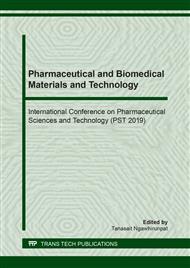p.202
p.209
p.215
p.221
p.227
p.233
p.240
p.246
p.252
Effect of Formulations and Spray Drying Process Conditions on Physical Properties of Resveratrol Spray-Dried Emulsions
Abstract:
Spray-dried emulsion is one of the useful strategies to enhance dissolution properties of poorly water-soluble drug for example resveratrol. Physical properties i.e. particle size and moisture content of spray-dried emulsions could affect their quality attributes. In this study, Box-Behnken design was performed in order to determine effect of formulation and spray drying condition parameters i.e. feed rate on responses including particle size and moisture content of resveratrol spray-dried emulsions. The spray-dried emulsions were prepared by varying content of low-methoxyl pectin (LMP) and caprylic/capric glycerides (CCG) and sprayed at different feed rate. Box-Behnken design results reveled that the particle size of spray-dried emulsions was significantly influenced by the content of LMP, interactions between LMP and CCG, interactions between LMP and feed rate. LMP content showed positive relationships with the particle size. The content of CCG had negative significantly effect on moisture content of the spray-dried emulsion. Mathematical models describing the relationships between studied parameters and responses provided good predictability. Based on model, the optimal formulation was prepared using 2.6% w/w of LMP, 9% w/w of CCG, and feed rate of 6.8 mL/min and the small particle size (~5.9 μm) and low moisture content (~5.6%) were obtained. The spray-dried emulsions were successfully prepared with satisfy quality. The Box-Behnken design would be an effective tool to elucidate influence of formulation and spray drying conditions on particle size and moisture content of the spray-dried emulsions. Further, the design aided in developing and optimizing the spray-dried emulsions with specified quality.
Info:
Periodical:
Pages:
246-251
Citation:
Online since:
August 2019
Keywords:
Price:
Сopyright:
© 2019 Trans Tech Publications Ltd. All Rights Reserved
Share:
Citation:


